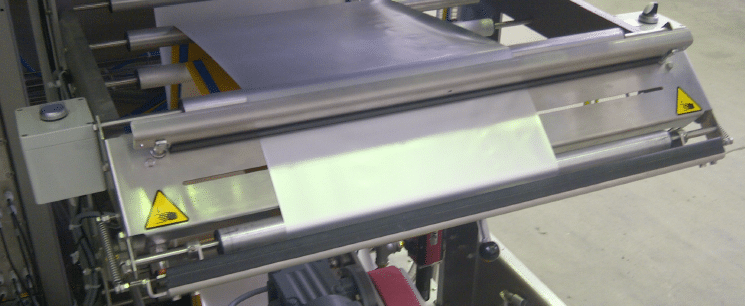Minimizing The Impact of VFFS Machine Non-Wear Component Failure
If you're hands-on with packaging machinery, you likely spend a lot of time making sure your packaging machinery stays up and running, changing wear...
4 min read
 Emily Brogan
:
Tue, Jan 4, 2022
Emily Brogan
:
Tue, Jan 4, 2022

Overall equipment effectiveness (OEE) is a game of inches. With the uptime of machinery having a direct impact on your bottom line, it's always an important factor for plant management, especially in a climate like today's where overhead costs have continued to rise.
Capital equipment is a big investment, and maximizing the amount of time it's making high-quality, saleable packages is the best way to boost its ROI. These are the types of factors that will make a tremendous difference shift after shift, year after year.
Of course, we can only speak on our technical capabilities and experiences, but here are a handful of the most impactful tools and features that we know to have a big impact on short and long-term OEE.
Depending on how close you work with packaging machinery, you may or may not know that splicing films together during production runs is a fact of life. Often, as one roll of film is used up, the next roll is staged and then loaded onto the machine so that it can be spliced together with the end of the old roll. For some equipment, the film then must be "jogged" or run through as empty packages until the spliced film makes it all the way through the bagger.

Film splice detection on ROVEMA equipment skips this step and the unnecessary waste associated.
So how does film splice detection work? By utilizing an ultrasonic sensor on upper film carriage that detects the tape splice. The machine can either produce a double bag that can be discharged away with a swivel discharge chute or the machine stops filling right before spliced film.
While this is a convenient tool to prevent film waste during film roll changes, this is especially helpful in preventing messes when a film splice is unexpected. Occasionally, rolls of film come in with splices somewhere in the middle of the roll itself where the film producer had to splice it together during production. For some product types, we consider this tool to be necessary, like with liquid products where an unexpected splice can be catastrophic.

When packaging product at the top range of today's run rate capabilities, specifically on continuous motion vffs machines, often there is more than one dose of product in the filling tube at one time, meaning that the margin for error is extremely small for clean charges.
In the off-chance that a piece of chocolate, coffee bean, or marshmallow gets caught between the seal jaws, hyper-sensitive technology that can detect this product before the jaws advance to sealing can help to avoid undetected compromised seals and can greatly reduce clean up times, particularly if your products contain sugars that cause buildup on the jaws.
Here are more details on product detection technology, Sense and Seal®.
Depending on your package type, you'll benefit from some level of automatic film tracking technology to help you automate the prevention of any seal integrity issues from the film running off-center. For some simpler package types like pillow bags, a standard two-eye sensor system goes a long way toward automating this parameter. It works by keeping the film edge between two sensors, using photo eyes to ensure only one is exposed and the other is covered by the film. If both are exposed, or both covered, the machine knows which direct to correct.
For premium package styles like Stabilo® four-corner seal packages, it's often needed to have more sophisticated technology like an ultrasonic film tracking solution that keeps tight tolerances on the vertical seal. This is necessary to prevent the "flash" of seeing the inner sealant layer.
For ROVEMA VFFS machines, the entire film carriage is mobile, so if the film tracking technology detects the film is outside of tolerance, the entire carriage shifts to correct it within a few cycles, instead of having to wait for the film to travel through all of the rollers before the seals are corrected.
A fully integrated checkweigher constantly monitors products as they are coming from the bagger and if it detects a trend of incrementally over or underweight packages, it automatically sends a signal for the filling component to adjust slightly to correct the package weights.
This completely eliminates the need to pull packages off of the line to weigh them and allows for an extremely self-sufficient packaging line.
A low film detection sensor on the back of your VFFS machine can go a long way in minimizing stoppage time on your packaging line during runs. Powered by a proximity switch just like your "out of film" detection, this signals your operator that a new roll of film needs to be staged and ready to be spliced onto the low roll.
This sensor can also serve as a great failsafe to an "out of film" prox switch needing to be replaced, which can be a huge pain to deal with if film has to be reloaded through the film carriage of the machine.
Barcode detection or reading is often only used as a quality control function but can go a long way of minimizing the headache of the simple human error of pulling and splicing the wrong film.
This technology works by automatically reading the UPC code occasionally and if it doesn't pass according to the HMI, the machine will automatically stop and throw an error code. This can be especially imperative for facilities that package products that contain allergens and can also quickly detect any issues that could come up at the point of sale like a print issue with the UPC itself on the package.
When the operator sets up to run a product, the VFFS machine's HMI asks for the barcode and then automatically loads the operation recipe with the proper sealing parameters for the film.
Simple tools like the ones above can make a huge difference for your business over the life of your equipment, not only in making life easier for your operators and engineers but even throughout your supply chain.
Every one of these solutions allows you to lower your impact on the planet, by reducing product and packaging waste - all while feeding the world.
If you have any questions or would like any additional info or videos on these solutions, feel free to request materials in the help box 👉👉 or by getting in touch with our experts at our contact us page.

If you're hands-on with packaging machinery, you likely spend a lot of time making sure your packaging machinery stays up and running, changing wear...

{% video_player "embed_player" overrideable=False, type='scriptV4', hide_playlist=True, viral_sharing=False, embed_button=False, autoplay=True,...

Spending some to save more Industrial operations, especially in the food industry, are all about minimizing costs, both operational and capital....